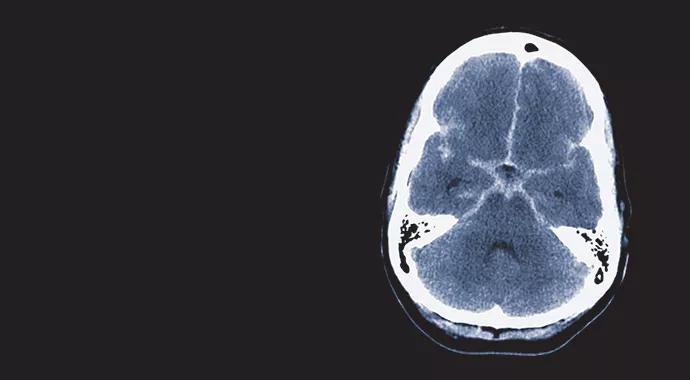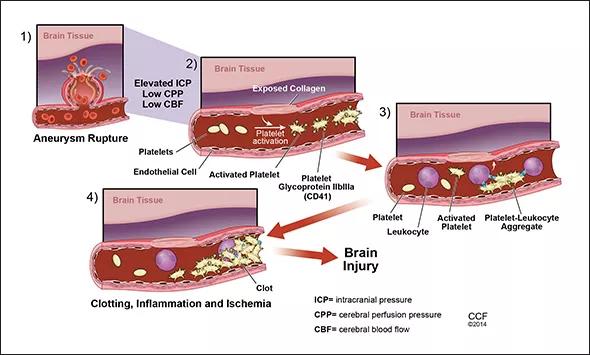Research sheds light on etiology for early injury after aneurysm rupture

By Jennifer A. Frontera, MD
Cleveland Clinic is a non-profit academic medical center. Advertising on our site helps support our mission. We do not endorse non-Cleveland Clinic products or services. Policy
Subarachnoid hemorrhage (SAH) — one of the most devastating forms of stroke — typically strikes in the prime of life, between ages 40 and 60. Less than half of patients with SAH can return to work at their premorbid level, and many more suffer physical and psychosocial effects that impair function.
Currently, the most important predictor of functional outcome after SAH is the early brain injury incurred at the time of aneurysm rupture, yet little is known about the mechanism of insult and no therapeutic treatments for acute brain injury are currently available.
Recent research from Cleveland Clinic’s Cerebrovascular Center and Neurocritical Care Program sheds light on a possible etiology for early brain injury after cerebral aneurysm rupture.
Admission neurological status — measured by Hunt-Hess grade, from 1 (mild headache or neck stiffness) to 5 (coma) — after SAH reflects acute brain injury and is a better predictor of death or severe disability than any other factor or complication that occurs as a result of aneurysm rupture (such as vasospasm).1,2 Indeed, sicker patients (Hunt-Hess grades 4-5) have devastating outcomes, with 12-month mortality rates ranging from 43 to 100 percent.3,4
Advances in neurocritical care and endovascular treatment of secondary injury after SAH (including vasospasm) have improved outcomes, yet there are no therapeutic options addressing the primary insult, which occurs at the time of aneurysm rupture. A mechanistic understanding of neurological dysfunction after SAH may open new avenues for therapeutic intervention.
Based on animal studies, one possible mechanism for early brain injury after SAH is platelet-leukocyte interaction leading to microthrombosis and infarction.5 Aneurysm rupture causes endothelium disruption and exposure of the underlying matrix collagen, which is a potent platelet activator.
Additionally, aneurysm rupture results in transiently elevated intracranial pressure with concomitant inadequate cerebral blood flow and, in some circumstances, intracranial circulatory arrest.6 As a consequence, platelets and leukocytes are activated and aggregate, mimicking the brain injury cascade that occurs after cardiac arrest. These platelet-leukocyte aggregates can obstruct the microcirculation, leading to ischemia and infarction (Figure).

Figure. Schematic of the platelet and leukocyte cascade that follows aneurysm rupture. Aneurysm rupture (1) is followed by increased intracranial pressure (ICP) and by low cerebral perfusion pressure (CPP) and low cerebral blood flow (CBF). Endothelial disruption at the rupture site and related reperfusion injury exposes collagen, which activates platelets (2). Activated platelets bind to leukocytes to form platelet-leukocyte aggregates (3). These aggregates obstruct flow in small vessels, leading to microthrombosis and ischemia (4). Diffuse microvascular ischemia leads to brain injury.
We have found evidence of acute platelet activation and markers of inflammation in humans after SAH that correlate with poor admission neurological status (early brain injury) and worse functional outcome.7
Moreover, we have investigated early ischemia after SAH using MRI. Examining 61 patients with SAH who prospectively underwent MRI acutely after SAH (within three days of aneurysm rupture),8 we found that 66 percent had evidence of ischemia. Patients with worse admission neurological status had higher volumes of ischemia. Follow-up MRIs were performed on these patients at days 4-7 and 7-10 after aneurysm rupture. Patients who developed acute ischemia (as shown on MRI) incurred most of their ischemic burden within the first three days after aneurysm rupture (before onset of vasospasm) and had significantly more ischemia during their hospital stay than those who did not have acute ischemia. Higher volumes of ischemia on MRI were significantly associated with an increased risk of death or severe disability at three months.
Although the pathogenesis of this observed radiographic ischemia acutely after SAH is not well understood, one possibility is that the platelet activation and inflammation we have observed may lead to obstruction of small vessels and to consequent micro-infarctions.9 This theory is supported by our MRI data, which reveal that 75 percent of acute infarctions are punctate, occurring at the small vessel level, rather than occurring in a segmented vessel distribution.
Intracranial circulatory arrest may also contribute to ischemia. This concept is supported by the observation of watershed-pattern ischemia in our and other MRI studies early after SAH.10
Using more sophisticated tests of platelet function and platelet-leukocyte interactions, we hope to drill down on the cascade of events that occur at the small vessel level and lead to acute brain injury. We plan to correlate platelet-leukocyte interactions with MRI evidence of ischemia using sophisticated MRI analysis software.
If we determine that platelet-leukocyte interactions are associated with worse early neurological status (implying early brain injury) and MRI evidence of ischemia after SAH, this would imply that therapeutic interventions that attenuate platelet-leukocyte interactions might be clinically useful.

Real-world claims data and tissue culture studies set the stage for randomized clinical testing

New grant-funded investigation illustrates impact and reach of Cleveland Clinic Brain Study

How the new longitudinal investigation could become the Framingham Heart Study of brain health

Pilot findings show good patient acceptance and safety, early hints of efficacy

Study finds high prevalence of symptoms, willingness to seek treatment

Panel outlines research priorities around a promising alternative to imaging markers

Suspected factors include antithrombotic intensity, time on device, presence of thrombocytopenia

Preclinical studies will assess whether method developed for stroke recovery curbs deficits after brain injury